Male Mahadeshwara Hills
Male` Mahadeshwara Betta is a pilgrim town located in the Hanur taluk of Chamarajanagar district of southern Karnataka. It is situated at about 150 km from Mysuru and about 210 km from Bengaluru. The ancient and sacred temple of Sri Male Mahadeshwara is a pilgrim centre where Mahadeshwara lived, practiced medicine as Sidda,taught ahimsa to people in and around the seven hills.It draws lakhs of pilgrims from the states of Karnataka and Tamil Nadu. The area of the present temple surroundings is 155.57 acres (0.6296 km2). In addition, the temple has lands at Talabetta, Haleyuru and Indiganatha villages. Amidst dense forest, the temple attracts not only the pilgrims but also nature lovers. The height of the hill is about 3000 feet above sea level.
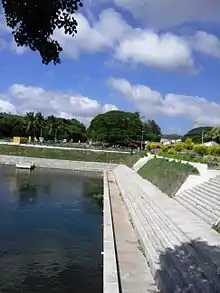
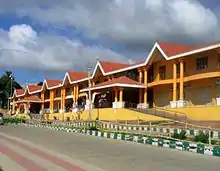

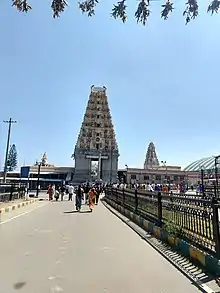

Male Mahadeshwara Hills | |
|---|---|
Pilgrimage centre | |
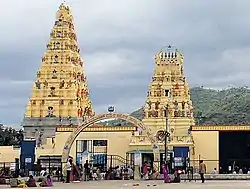 Male Mahadeshwara Hills | |
| Country | |
| State | Karnataka |
| District | Chamarajanagara |
| Named for | Mahadeshwara |
| Government | |
| • Type | Muzarai |
| • Body | Karnataka State Governament |
| Languages | |
| • Official | Kannada |
| Time zone | UTC+5:30 (IST) |
| Nearest city | Hanur |
| Website | mmhillstemple |
The Lord Sri Mahadeshwara is believed to be the incarnation of Lord Shiva. Historical evidences suggest that the Saint Mahadeshwara must have lived during the 15th century. About 600 years ago, he came here to perform penance and it is believed that he is still performing penance in the temple's garbha gudi in the form of a linga. The linga, worshipped now in the garbha gudi, is a self-manifested (swayambhu) one. Sri Male Mahadeshwara Swamy was moving on a tiger known as Huli Vahana (Tiger as a vehicle) and performed a number of miracles around the Betta to save the people and saints living there. The Lord Sri Mahadeshwara's miracles are sometimes sung by the village folk in Janapada Style.
The story of Mahadeshwara
According to legends, Lord Maley Mahadeshwara was born in the Kali Yuga to a fair coloured woman known as Uttarajamma and Chandrashekhara Murthy of Adi Jambhava Community.
He has spiritually guided by then pontiff of Suttur Mutt and Kunthur Mutt (Lingayat Mutts). The young saint is supposed to have come from Srishaila to this part of the state. He is said to have performed several miracles in his life, in these places. Afterwards he went to the hills of Male Mahadeshwara. It is a dense forest area surrounded by seventy seven peaks in seven circles. It was not a safe place for human habitation. It was about six centuries ago that the young saint went in to the forest area, to save the saints who were performing penance and were taken captive by an evil king known as Shravana who possessed abundant black magic power. Apart from this there were tribes living here and there in small groups who were devoid of any rays of human civilization. It is said that Sri Mahadeshwara destroyed the black magic power of Shravana and released the saints who were in his prison. The place where they were kept captive is also a holy place, called Thavasere and the place where Shravana lived is called Shravana Boli.[1]
According to tradition there are seven peaks identified in the legend, which are as follows :
Anumale, Jenumale, Kanumale, Pachchemale, Pavalamale, Ponnachimale and Kongumale. These seven peaks together form the M.M.Betta. It is said that the saint Lord Mahadeshwara established a Mutt here for looking after the religious and cultural affairs of the people of this area. It is also said that, through his miracles, he enlightened and uplifted the hill tribes & made them his disciples. The people coming from these families have become hereditary 'Archaks' of the Mahadeshwara temple. The temple was under the control & management of Sri Salur Mutt established by the Lord Mahadeshwara himself until it was handed over to the Madras Government in the year 1953. After the formation of the state of Karnataka, the administration of the Temples is done by the trust committee, appointed by the Karnataka Government under the Muzrai Department.[1]
Tourism
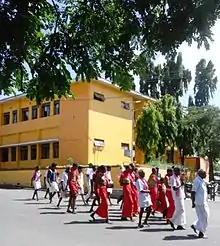
Male Mahadeshwara Hills have become a tourist destination of Chamarajanagar district. The hilltop of well developed with paved roads and tiled footpaths. Visitors are allotted separate villas to stay on payment of a small amount. There are many shops sellings curios and pooja items.
About 50 years ago there was no road facilities to this place. People used to reach the place by walking. At present there are road connections from Karnataka and Tamil Nadu States. More than 100 buses are plying in this route everyday. There are several places of historical interest in this area to which the devotees often pay their visits. A pilgrimage to Male Mahadeswara temple also includes a holy dip in the "antaragange", a stream flowing from a perennial source.[2]
Kamsale
The song and dance routine is called Kamsale. Kamsale is closely connected with a tradition of Shiva worship. Only those who have vowed to live a life of devotion to Mahadeshwara are supposed to perform kamsale. The dance is a part of a 'deeksha' or oath and is taught by a teacher or spiritual leader. Kamsale artists are illiterates and have no printed literature. They learn those songs orally. They participate in fairs, which are held in Mahadeshwara Betta during 'Deepavali', 'Shivaratri' and 'Ugadi' festivals.[3] Hence, Mahadeshwara is also known as Badawara devaru Madappa "Chellidaru Malligeya" is a famous folk song that describes the devotion and worship of lord Mahadeshwara.
"kamsale mainly seen in karthika Mondays and shivarathri in m m hill "
Epic
The epic story of Mahadeshwara describes the life and miracles of the saint. The outer structure of the epic resembles the pan-Indian Ramayana : Shiva incarnates himself on earth as Mahadeshwara to destroy an evil king called Shravanasura ('The Hero as Saviour' motif). The epic has seven parts; and normally, only certain parts are sung as dictated by the taste of the audience or patron. However, the entire epic is sung by some pilgrims on their way to the annual fair on the Mahadeshwara Betta; and it may last for seven consecutive nights.
The epic (single-narrator version) has seven parts. After traditional invocation, the first part narrates the immaculate birth, childhood, and spiritual quest of Mahadeshwara. The second part narrates the ways through which Mahadeshwara gets a wealthy farmer Junje Gowda as his devotee to build him a temple on the Seven Betta. The next part is devoted to the destruction of the evil king, Shravanasura. Next we have the longest and most moving episode called 'Sankamma kathe'. This episode dramatises the suffering of a proud woman called 'Sankamma,' and the ordeals that she successfully undergoes in order to retain her dignity as a virtuous wife. The fifth episode, slightly comic in tone, depicts the rise and fall of a vainglorious and miserly woman, called 'Bevinatti Kalamma.' The last but one episode narrates how Mahadeshwara gets two simple and god-fearing people, Moogayya and his wife, as his devotee religion family. Mugayya family the grandson mahadeshwara . The concluding part, besides traditional ending with benediction, gives a brief summary of the entire epic.[4]
Forest wealth
Apart from being a pilgrimage centre, M.M.Hills possess large tracts of forest area. The landscapes of Betta and valleys are covered with forests. These forest types vary from evergreen forests in Ponnachi Boli to dry deciduous forests in most other parts. M.M.Betta is bound by the river Kaveri to the north-east and by the river Palar to the south.
The forests of M.M.Betta have been famous for wonderful regeneration and stock of sandalwood and bamboo. The forests are inhabited by a variety of animals, birds and reptiles. They are found in large numbers too. Elephants are the most prominent species. The latest estimate puts the population of elephants are more than 2500 in the district, which includes Bandipur National Park too. Frequent sightings of guars (Indian bison), sambars, spotted deer, jackals, sloth bears, porcupine, etc., apart from rare sightings of tigers, leopards and wild dogs are possible in and around this area. The Male Mahadeshwara Reserve Forests, has an approximate area of 39361.45 hectares and has a few small villages like Ponnachi, Kombadikki, Kokkebore, Doddane, Tokere, Tulsikere,Puduru village ,Thambadi street or Thambadigere, Palar, Gopinatham, Indiganatham, etc., as enclosures within the reserve forests.[5]
According to media reports[6][7] a decision to declare 906.18 km2 (349.88 sq mi) (90,618.75 hectares) of 1,224 km2 (473 sq mi) of the Kollegalaa Range forest as Male Mahadeshwara Wildlife Sanctuary was taken during the fifth meeting of the Karnataka Wildlife Board held on 15 December 2012. The then chief minister Jagadish Shettar, who presided over the meeting, approved this under Section 26A (I) (B) of the Wildlife Conservation Act, 1972, (Amendment 2006) on 7 May 2013. But the same information is yet to reflect on the website of the Karnataka Forest Department.
References
- "HISTORY & LEGEND". Creative India Infotech.
- "Male Mahadeshwara Hills". Karnataka Holidays.
- "Kamsaale". Janapada loka. Archived from the original on 2 October 2013. Retrieved 29 September 2013.
- "Indian Folk Epics: The Story of Madeshwara". Dr.C.N.Ramachandran.
- Mahadeswara Hills
- http://www.deccanherald.com/content/332875/male-mahadeshwara-wildlife-sanctuary-comes.html
- Paneesha, V. (10 August 2013). "Impetus to wildlife conservation". The Hindu. Retrieved 22 May 2018.
External links
| Wikimedia Commons has media related to Male Mahadeshwara Hills. |